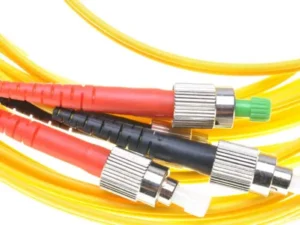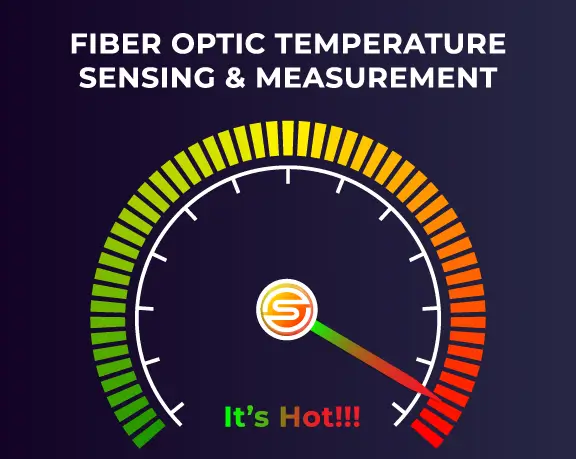Accurate temperature measurement is fundamental across various engineering disciplines. From ensuring the structural integrity of bridges to optimizing the performance of jet engines, precise temperature data plays a critical role in design, operation, and maintenance.
However, traditional temperature sensors often have limitations, hindering the ability to obtain a comprehensive understanding of thermal profiles.
Let’s explore fiber optic temperature sensing (FOSS) technology, and how it is revolutionizing temperature measurement.
We’ll delve into the groundbreaking capabilities of Sensuron’s Fiber Optic Sensing Systems (FOSS), showcasing their unique advantages over conventional sensors.
We’ll explore real-world applications across diverse industries and discuss the cost considerations associated with this innovative technology.
By the end of this article, you’ll gain a deeper understanding of how fiber optic temperature sensing can transform your approach to temperature monitoring and enhance your engineering projects.
In this ‘Fiber Optic Temperature Sensing: Transforming Monitoring’ article, we’ll discuss:
Introducing Sensuron’s Fiber Optic Temperature Sensing Systems
Traditional point sensors provide temperature data at a single location,limiting the ability to capture a complete picture of thermal distribution. This is where Sensuron’s Fiber Optic Temperature Sensing Systems come into play.
FOSS technology offers a groundbreaking alternative for temperature measurement, enabling continuous temperature profiling with high resolution along the entire length of an optical fiber.
Continuous Temperature Profiling with High Resolution
Unlike conventional sensors,Sensuron’s Fiber Optic Sensing System leverages fiber optic cables to acquire temperature data across thousands of points simultaneously. This distributed sensing approach allows for the creation of a detailed thermal profile, providing crucial insights into temperature variations along the entire fiber length.
Let us use a bridge under stress as an example.
- Traditional sensors might be placed at critical support points, but they wouldn’t capture the temperature fluctuations across the entire structure. In contrast, a single fiber optic cable embedded within the bridge can continuously monitor temperature variations throughout its entire span, revealing potential hotspots or areas of concern.
- The high resolution of Sensuron’s FOSS is another key advantage. Sensor spacing can be as low as 1.6 millimeters, enabling engineers to detect even the most minor temperature changes. This fine-grained detail is invaluable in applications where precise temperature control is critical, such as monitoring the performance of jet engines or optimizing the curing process of composite materials in aerospace structures.
How Fiber Optic Sensing Works
The inguinity behind Sensuron’s Fiber Optic Sensing Systems lies in the fascinating world of fiber optics.

These systems utilize thin, glass or plastic fibers that transmit light pulses. The core principle is based on the concept of light modulation, where changes in temperature influence the properties of light traveling through the fiber.
Here’s a closer look at the process:
- Light Source: A laser or LED light source launches a light pulse into the fiber optic cable.
- Light Interaction: As the light travels through the fiber core, it interacts with the surrounding material, including the material being monitored (e.g., the bridge structure).
- Temperature Sensitivity: Temperature variations along the fiber cause changes in the light’s properties, such as its intensity, phase, or wavelength.
- Signal Detection: The light pulse exits the fiber, and a specialized sensor detects these subtle changes in the light’s characteristics.
- Data Interpretation: Sophisticated software interprets the received signal, deciphering the temperature information encoded within the light’s properties. This software then translates this data into a detailed temperature profile along the entire fiber length.
The beauty of this technology lies in its simplicity and effectiveness. By utilizing readily available fiber optic cables and interpreting the way light interacts with temperature, Sensuron’s FOSS provides a powerful tool for engineers to gain a deeper understanding of thermal behavior in their applications.
Enhanced Capabilities of Fiber Optic Sensing
Fiber optic sensing technology offers several advantages over traditional temperature measurement methods. This section delves into two key capabilities of Sensuron’s Fiber Optic Sensing Systems (FOSS) that make them particularly valuable for engineers: high-density data acquisition for real-time mapping and unmatched suitability for harsh environments.
High-Density Data Acquisition for Real-Time Mapping
One of the most significant advantages of Sensuron’s FOSS is its ability to acquire temperature data at high density.

Unlike conventional point sensors that provide readings at specific locations, FOSS leverages the entire length of a fiber optic cable as a distributed sensor. This enables the simultaneous measurement of temperature at thousands of points along the fiber with millimeter-level spatial resolution.
Imagine a pipeline transporting oil across vast distances. Traditional temperature monitoring might involve placing sensors at specific pumping stations or checkpoints. However,these methods wouldn’t capture the temperature fluctuations that might occur throughout the pipeline.
In contrast, a single fiber optic cable embedded within the pipeline can provide a continuous temperature profile along its entire length. This real-time data allows for proactive maintenance and early detection of potential issues, such as leaks or blockages, before they escalate into costly problems.
The high-density data acquisition capability of Sensuron’s FOSS also translates to real-time mapping capabilities. By continuously monitoring temperature variations across a vast network of points, engineers can visualize thermal profiles in real-time, enabling them to make critical decisions based on the latest data. This is particularly beneficial in applications such as power cable monitoring, where early detection of overheating can prevent catastrophic failures.
Unmatched Suitability for Harsh Environments
Traditional temperature sensors can be susceptible to damage or malfunction when exposed to harsh environments.
Extreme temperatures, corrosive chemicals, or electromagnetic interference (EMI) can significantly impact the accuracy and reliability of conventional sensors. In contrast, Sensuron’s fiber optic temperature sensing systems are built to withstand these challenging conditions.
Fiber optic cables are inherently resistant to corrosion and electromagnetic interference, making them ideal for applications in the oil and gas industry, chemical processing plants, or high-voltage power substations. Additionally, the wide temperature range that FOSS can handle allows for their deployment in extreme environments, from cryogenic chambers to furnaces.
For instance, imagine monitoring the temperature of a chemical reactor vessel. Traditional sensors might be susceptible to corrosion from the harsh chemicals within the vessel. However, a fiber optic cable embedded in the vessel wall can provide continuous and reliable temperature data without risk of degradation.
Here’s why Sensuron’s FOSS excels in harsh environments:
- Chemical Inertness: Fiber optic cables are constructed from glass or plastic, making them highly resistant to a wide range of chemicals. This allows for deployment in environments where traditional sensors might be susceptible to corrosion or degradation.
- EMI Immunity: Fiber optic cables are immune to electromagnetic interference (EMI), a significant advantage in environments with high levels of electrical noise, such as power plants or near high-voltage transmission lines. EMI can disrupt the readings of traditional electronic sensors, but fiber optic sensors remain unaffected.
- Wide Temperature Range: Sensuron’s FOSS can operate effectively across a broad temperature range, making them suitable for applications in extreme hot or cold environments. This versatility allows for deployment in diverse settings, from monitoring the thermal performance of rocket engines to tracking temperature changes in cryogenic storage facilities.
The ability to withstand harsh environments makes Sensuron’s FOSS ideal for a wide range of industrial, energy, and scientific applications. They offer reliable and accurate temperature monitoring in conditions where traditional sensors might struggle.
Unveiling the Power of Sensuron’s FOSS Technology
While the high-density data acquisition and environmental resilience of Sensuron’s FOSS are impressive, the technology’s true potential lies in its unmatched technical specifications. This section dives into two key aspects that differentiate Sensuron’s FOSS from other fiber optic sensing systems: unparalleled spatial resolution and signal-to-noise ratio, leading to superior performance across various applications.
Unparalleled Spatial Resolution and Signal-to-Noise Ratio
Sensuron’s FOSS boasts exceptional spatial resolution, allowing engineers to measure temperature variations with incredible detail. Sensor spacing within the fiber optic cable can be as low as 1.6 millimeters, providing a much finer-grained view of temperature distribution compared to traditional sensor technologies.
Consider monitoring the temperature profile of a composite aircraft wing. Traditional sensor arrays might miss subtle temperature fluctuations within the material. However, a single fiber optic cable embedded within the wing can capture these minute variations with high resolution, enabling engineers to detect potential damage or stress points before they become critical issues.
Furthermore, Sensuron’s FOSS delivers an impressive signal-to-noise ratio. This ratio indicates the strength of the desired temperature signal compared to any background noise that might interfere with the measurement. A high signal-to-noise ratio ensures accurate and reliable temperature data, even in noisy environments with vibrations or electrical interference.
Think about monitoring a geothermal well for temperature changes. Traditional sensors might struggle with the vibrations and noise inherent in such environments. In contrast, Sensuron’s FOSS technology can effectively distinguish the temperature signal from the background noise, providing engineers with clear and reliable data for analysis.
The combination of exceptional spatial resolution and high signal-to-noise ratio makes Sensuron’s FOSS a powerful tool for engineers who require precise and reliable temperature data across diverse applications.
Technical Advantages for Superior Performance
Beyond the user-facing benefits of high resolution and signal-to-noise ratio, Sensuron’s FOSS technology offers several technical advantages that contribute to its superior performance. Here are some key highlights:
- Advanced Signal Processing: Sophisticated algorithms are employed to extract the temperature information encoded within the light signal. These algorithms ensure accurate data interpretation and minimize errors.
- Distributed Sensing: Unlike traditional point sensors, FOSS measures temperature along the entire fiber length, providing a more comprehensive understanding of thermal behavior.
- Scalability: FOSS systems can be readily scaled to accommodate various fiber optic cable lengths, making them suitable for projects of different sizes and complexities.
- Durability: Fiber optic cables are known for their robustness and resistance to wear and tear. This translates to reliable long-term performance for Sensuron’s FOSS systems.
These technical advantages, coupled with the user-centric benefits discussed earlier, solidify Sensuron’s FOSS technology as a leader in the field of distributed fiber optic temperature sensing.
Practical Applications and Benefits Across Industries
Sensuron’s Fiber Optic Temperature Sensing (FOSS) technology transcends specific industries, offering valuable advantages in various engineering fields. This section explores how FOSS empowers engineers in several key sectors:
Aerospace: Ensuring Mission Success and Safety
The success of aerospace missions hinges on meticulous thermal management. Here’s how Sensuron’s FOSS contributes to a safer and more efficient aerospace industry:
- Optimizing Thermal Insulation Design: Traditional methods for evaluating thermal insulation rely on simulations and point sensors. However, these approaches might not capture the intricacies of heat transfer across complex aerospace structures. FOSS, with its continuous temperature profiling capabilities, allows engineers to precisely map thermal distribution within insulation systems. This data can be used to optimize insulation design, ensuring optimal performance and minimizing weight, a critical factor in aerospace applications.
- Identifying and Mitigating Thermal Hotspots: Thermal hotspots can pose significant risks in aerospace vehicles. FOSS, with its high-density data acquisition and exceptional spatial resolution, enables engineers to pinpoint these hotspots with unprecedented precision. Early detection of thermal anomalies allows for preventive maintenance and mitigates the risk of critical component failure, enhancing overall mission safety.
By contributing to a deeper understanding of thermal behavior within aerospace vehicles, Sensuron’s FOSS technology empowers engineers to design more efficient and reliable systems, ultimately contributing to successful missions.
Civil Structural Health Monitoring: Building with Confidence
The integrity of civil infrastructure is paramount for public safety. Sensuron’s FOSS plays a vital role in ensuring the structural health of bridges, buildings, and other critical civil engineering projects.
- Thermal Management of Composite Materials and Batteries: The increasing use of composite materials in civil infrastructure presents unique thermal management challenges. These materials can exhibit anisotropic thermal conductivity, meaning heat transfer properties vary depending on direction. FOSS, with its distributed sensing capabilities, provides a comprehensive understanding of thermal profiles within composite structures. This allows engineers to optimize designs for efficient heat dissipation and prevent potential thermal runaway scenarios, especially in structures that incorporate battery storage systems.
- Ensuring Uniformity in Curing Processes and Heat Exchangers: Uniform temperature distribution is crucial during the curing process of concrete and other construction materials. Traditional point sensors might miss localized variations in temperature, potentially leading to structural weaknesses. FOSS, with its continuous temperature profiling, enables engineers to monitor temperature uniformity throughout the curing process. Similarly, FOSS can be integrated into heat exchangers to ensure optimal heat transfer efficiency in building HVAC systems, leading to improved energy performance.
By bringing real-time insights into thermal behavior within civil structures, Sensuron’s FOSS technology empowers engineers to design, construct, and maintain safe and reliable infrastructure.
General Industrial Applications: Streamlining Processes
The benefits of Sensuron’s FOSS extend beyond specialized engineering fields. Here’s how FOSS can revolutionize temperature monitoring in general industrial applications:
- Enhanced Uniformity Control in Temperature-Sensitive Processes: Many industrial processes rely on precise and consistent temperatures. From food and beverage production to chemical manufacturing, even minor temperature fluctuations can disrupt quality or yield. FOSS, with its high-density data acquisition, enables real-time temperature mapping throughout reactors, vessels, or processing lines. This allows for more precise control over heating or cooling systems, ensuring exceptional uniformity and minimizing product defects.
- Reduced Installation Complexity and Improved Monitoring Efficiency: Traditional temperature monitoring systems often involve a complex network of point sensors and extensive cabling. Installing and maintaining these systems can be time-consuming and expensive. In contrast, Sensuron’s FOSS leverages a single fiber optic cable, simplifying installation and reducing overall system complexity. Furthermore, the distributed sensing nature of FOSS eliminates the need for multiple data acquisition points, streamlining the monitoring process and reducing maintenance costs.
By offering a more efficient and cost-effective way to monitor temperature, Sensuron’s FOSS technology empowers industrial facilities to optimize processes, improve product quality, and reduce waste.
Cost Considerations: A Long-Term Investment
The upfront cost of implementing Sensuron’s Fiber Optic Temperature Sensing (FOSS) technology might appear higher compared to traditional point sensor systems. However, a closer look reveals FOSS to be a wise long-term investment that delivers significant cost savings and efficiency gains.
Initial Cost vs. Long-Term Savings and Efficiency Gains
While the initial investment in a Sensuron’s FOSS system might be higher than traditional sensor setups, several factors contribute to substantial long-term savings:
- Reduced Sensor Costs: FOSS eliminates the need for multiple point sensors, reducing overall sensor hardware costs.
- Simplified Installation: The ease of installation with a single fiber optic cable minimizes labor costs associated with traditional wired sensor networks.
- Lower Maintenance Requirements: The inherent durability of fiber optic cables and the reduced number of components lead to lower maintenance requirements compared to traditional sensor systems.
- Improved Process Efficiency: The real-time temperature monitoring and precise control capabilities of FOSS can optimize industrial processes, minimizing product waste and improving production yields.
- Reduced Downtime: Early detection of potential issues through continuous temperature monitoring allows for preventive maintenance, reducing the risk of unexpected downtime and production losses.
By considering these long-term benefits, Sensuron’s FOSS technology emerges as a cost-effective solution that delivers a strong return on investment (ROI) over a typical system lifespan. The improved process efficiency, reduced waste, and minimized downtime translate to significant cost savings for industrial facilities.
In conclusion, let’s share with you the;
5 key advantages of Sensuron’s Fiber Optic Temperature Sensing Technology
Let’s explore, Once Again, the Power of FOSS and the 5 Key Advantages of Sensuron’s Fiber Optic Temperature Sensing (FOTS) Technology
- Real-time, High-Resolution Temperature Monitoring: FOSS offers a significant leap forward compared to traditional methods by providing real-time data acquisition and unmatched spatial resolution for precise temperature mapping.
- Benefits Across Industries: FOSS empowers engineers in diverse fields like aerospace, civil engineering, and general industries by addressing critical needs in thermal management, process optimization, and structural health monitoring.
- Cost-Effective Long-Term Solution: While the initial investment might be higher, FOSS delivers long-term cost savings through reduced sensor requirements, simplified installation, lower maintenance needs, and improved process efficiency.
- Future-Proof Technology: Research and development in FOSS are focused on continuous improvement, with advancements in sensitivity, measurement range, miniaturization, and AI integration for even more powerful monitoring capabilities.
- Suitable for Harsh Environments: Unlike traditional sensors, FOSS technology is well-suited for harsh environments due to its inherent durability and resistance to external factors.
The Future of Temperature Measurement with Sensuron’s Fiber Optic Sensing
The future of temperature measurement is bright, and fiber optics plays a central role. Sensuron’s FOSS technology is at the forefront of this revolution, continuously evolving to push the boundaries of what’s possible. Here’s a glimpse into what the future holds:
- Enhanced Sensitivity and Measurement Range: Research and development efforts are focused on even greater sensitivity and a wider temperature measurement range. This will allow FOSS to tackle an even broader spectrum of applications.
- Miniaturization and Integration: Advancements in fiber optic technology are paving the way for miniaturized FOSS sensors, enabling easier integration into space-constrained environments and potentially even embedding them directly within materials.
- Artificial Intelligence Integration: The future holds immense potential for integrating FOSS with artificial intelligence (AI) for real-time anomaly detection, predictive maintenance, and automated process control.
By staying at the forefront of innovation, Sensuron is ensuring that FOSS remains the leading solution for intelligent temperature monitoring in the years to come. As new capabilities emerge, engineers will have access to even more powerful tools to design, optimize, and manage with unprecedented precision.
Empower Your Team with Intelligent Temperature Monitoring
Harness the power of Sensuron’s FOSS for real-time temperature monitoring to optimize performance in your projects. Contact Sensuron today to discuss how their advanced Fiber Optic Sensing (FOSS) systems can empower your engineering team.
Goodreads:
- Sensor density of strain gauges vs fiber optic sensing
- Fiber Optic Sensing vs Strain Gauges – Installation Effort/Complexity
- Fiber Optic Sensing vs Strain Gauges – Episode 1
- Fiber optic sensing: The past, present, and exciting future

